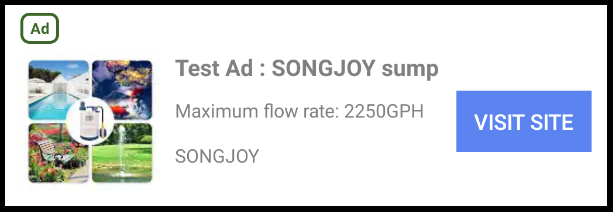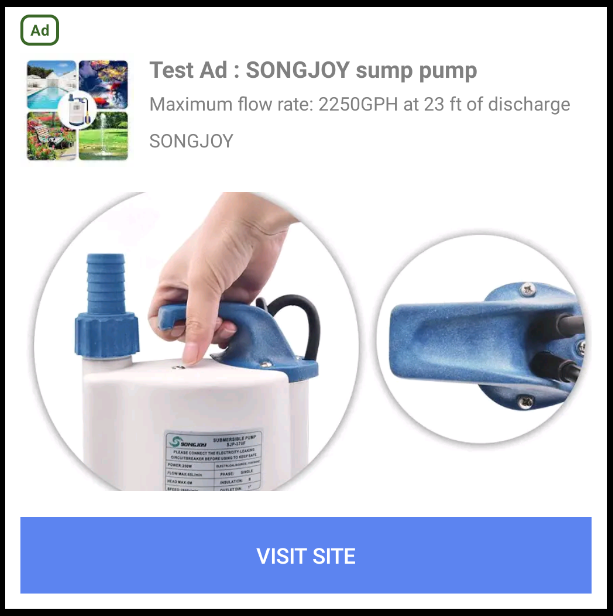Native Ads
Native ads allow you to customize the look and feel of the ads that appear in your app. You design the ads from the ground up: how they look, where they’re placed, and how they work within your existing app design.
Using native ads you can customize your ads resulting in a better user experience. Better user experiences can increase engagement and improve your overall yield.
Currently only Native Ad Templates are implemented. If you need a custom view implementation please contact our custom development team at airnativeextensions@distriqt.com
Load an Ad
Native ads are loaded via the NativeAd class.
Firstly create an instance of the NativeAd by calling Adverts.service.nativeAds.createNativeAd() passing your unit id:
var nativeAd:NativeAd = Adverts.service.nativeAds.createNativeAd( "ca-app-pub-3940256099942544/2247696110" );
To load an ad call the loadAd() function of the NativeAd instance and pass an AdRequest object which will specify the details of the ad request to load. You create an AdRequest by using the AdRequestBuilder. The builder is used to correctly create the request object and easily set the availble properties on the request.
The simplest example is to just use a generic request:
nativeAd.load( new AdRequestBuilder().build() );
You can set properties, such as adding a gender to the request, using the other methods on the builder:
var request:AdRequest = new AdRequestBuilder()
.setGender( AdRequest.GENDER_MALE )
.build();
nativeAd.load( request );
See Targeting for more on the AdRequestBuilder targetting options.
The load process will dispatch one of two events:
NativeAdEvent.LOADED: On successful load of a native ad;NativeAdEvent.ERROR: If there was an error, (eg invalid account, unit id etc)
var nativeAd:NativeAd = Adverts.service.nativeAds.createNativeAd( "ca-app-pub-3940256099942544/2247696110" );
nativeAd.addEventListener( NativeAdEvent.LOADED, loadedHandler );
nativeAd.addEventListener( NativeAdEvent.ERROR, errorHandler );
nativeAd.load( new AdRequestBuilder().build() );
function loadedHandler( event:NativeAdEvent ):void
{
trace( "native ad loaded" );
}
function errorHandler( event:NativeAdEvent ):void
{
trace( "errorHandler: " + event.errorCode + "::"+event.errorMessage );
}
As opposed to some other formats, you cannot show a native ad until the load is complete.
Testing and Development
It is very important that while you are developing your application that you do not serve live ads. This is a requirement of the usage of AdMob and not following this correctly can have your application id blocked from using AdMob.
While in development you should either use the test ad unit ids available or specify your test device id in your ad requests. More information on this is located in the section on Test Ads
Display
We have provided access to the native templates to get started with native ads.
If you require more specific customisation on how your ads are displayed, you can contact our custom development team at airnativeextensions@distriqt.com
There are two templates: small and medium.
Small Template
The small template is ideal for lists or any time you need a long rectangular ad view (similar to a banner).

Medium Template
The medium template is meant to be a one-half to three-quarter page view but can also be used in feeds. It is good for landing pages or splash pages.

Show
To use a template call the showWithTemplate() function. This function takes two parameters, the type of template and view parameters to position and size the ad.
For the small sized template:
nativeAd.showWithTemplate( NativeAdTemplate.SMALL, params );
For the medium sized template:
nativeAd.showWithTemplate( NativeAdTemplate.MEDIUM, params );
You must specify the size and position for the advert in order for it to be correctly created. Here params is an instance of AdViewParams. You must at least provide the width and height for the ad:
var params:AdViewParams = new AdViewParams();
params.width = 800;
params.height = 800;
nativeAd.showWithTemplate( NativeAdTemplate.MEDIUM, params );
Size and Position
To control the size and position of the advert, use the setViewParams() function. This function uses the AdViewParams class to communicate position and size of the native ad.
To set the position:
var params:AdViewParams = new AdViewParams();
params.x = 50;
params.y = 50;
params.width = 800;
params.height = 400;
nativeAd.setViewParams( params );
You must specify a width or height for a native ad! Unlike other ad formats the content is created and sized from a template according to your needs so it is very important that you provide size information.
To retrieve the displayed position and size of the advert use the getViewParams() function.
var params:AdViewParams = nativeAd.getViewParams();
trace( "AD WIDTH: " + params.width );
trace( "AD HEIGHT: " + params.height );
Styling
You can style the templates by providing a custom NativeAdTemplateStyle instance to the showWithTemplate() function.
The NativeAdTemplateStyle has a range of functions to control various styles, such as text sizes and background colours.
var style:NativeAdTemplateStyle = new NativeAdTemplateStyle()
.setMainBackgroundColor( 0xFFFF00FF )
.setCallToActionBackgroundColor( 0xFFFF0000 )
.setPrimaryTextBackgroundColor( 0xFF00FF00 )
.setSecondaryTextBackgroundColor( 0xFF0000FF )
.setTertiaryTextBackgroundColor( 0xFF000000 );
This instance is passed as the second parameter to the showWithTemplate() function:
nativeAd.showWithTemplate( NativeAdTemplate.MEDIUM, params, style );
Example
var nativeAd:NativeAd = Adverts.service.nativeAds.createNativeAd( "ca-app-pub-3940256099942544/2247696110" );
nativeAd.addEventListener( NativeAdEvent.LOADED, loadedHandler );
nativeAd.addEventListener( NativeAdEvent.ERROR, errorHandler );
nativeAd.load( new AdRequestBuilder().build() );
function loadedHandler( event:NativeAdEvent ):void
{
var params:AdViewParams = new AdViewParams();
params.width = 800;
params.height = 400;
var style:NativeAdTemplateStyle = new NativeAdTemplateStyle()
.setMainBackgroundColor( 0xFFFF00FF )
.setCallToActionBackgroundColor( 0xFFFF0000 )
.setPrimaryTextBackgroundColor( 0xFF00FF00 )
.setSecondaryTextBackgroundColor( 0xFF0000FF )
.setTertiaryTextBackgroundColor( 0xFF000000 );
nativeAd.showWithTemplate(
NativeAdTemplate.SMALL,
params,
style
);
}
function errorHandler( event:NativeAdEvent ):void
{
trace( "errorHandler: " + event.errorCode + "::"+event.errorMessage );
}